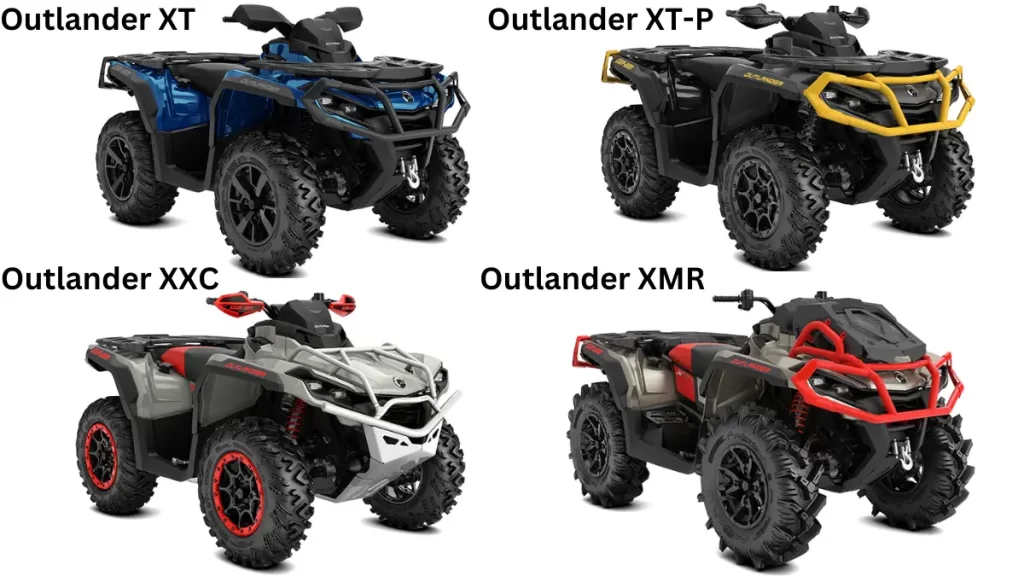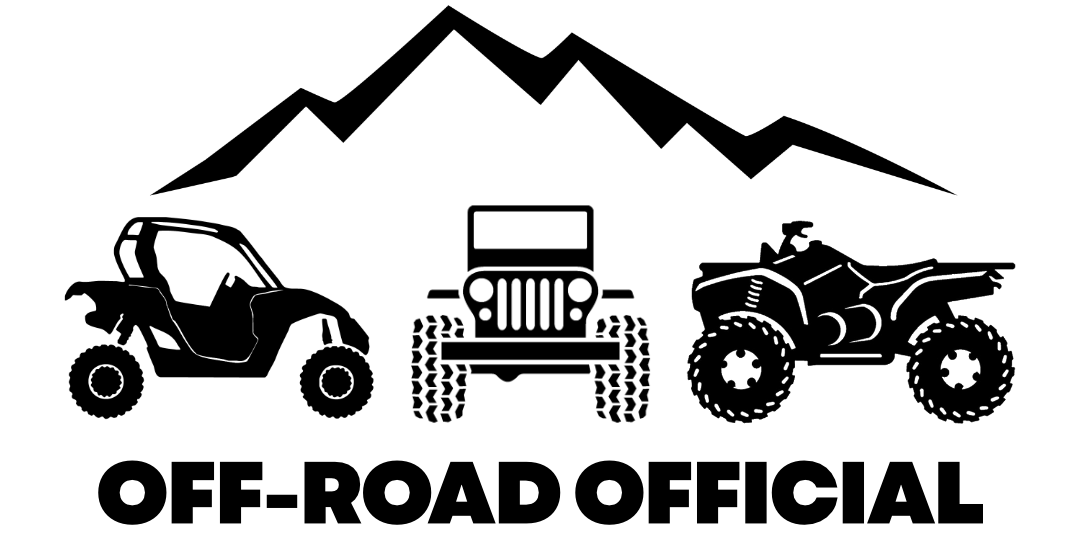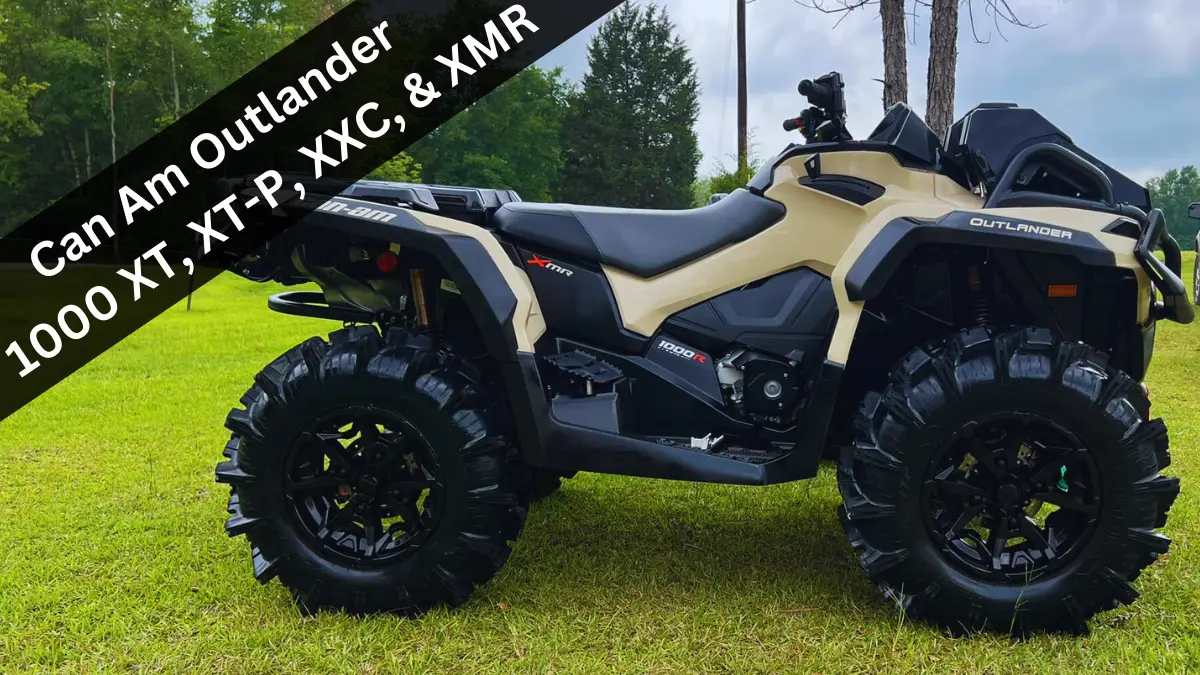The Can Am Outlander 1000 is one of the most thrilling all-around ATVs you could possibly take for a spin.
There are four main Outlander 1000 models, each with plenty of similarities and plenty of differences.
- Can Am Outlander 1000 XT
- Can Am Outlander 1000 XT-P
- Can Am Outlander 1000 XXC
- Can Am Outlander XMR
So how fast do each of the Outlander 1000 models go?
And besides the speed, what else should you know about them before pulling the trigger on one?
This guide will help answer those questions in reviewing the following:
- Top speeds of all four Outlander 1000 models
- Why some models are faster than others
- Type of riding each is best suited for
- Cost of each
- Side by side comparison and key differences
- Engine
- Drivetrain
- Gearing
- Suspension
- Tires
- Dimensions
- Accessories
- Which model is recommended as the best all-around
Can Am Outlander 1000 Top Speed
Of the four main Can Am Outlander 1000 models, surprisingly one is quite slower than the others in stock condition.
The Can Am Outlander XT, XT-P, and XXC models can all reach a top speed of 78 mph while the Can Am Outlander XMR 1000 top speed is 65 mph.
This leaves the Outlander XMR off the list of fastest ATVs in the industry for 2024.
Similar to the Can Am Renegade 1000 models, this difference in top speeds is due to the Outlander XMR being limited by an electronic speed limiter because of the size of its stock tires.
The other three models come equipped with smaller tires and do not have a speed limiter in place.
The good news for owners with a need for speed is that by making some modifications to your Outlander 1000, you can achieve a much faster top speed in any model to keep up with some of the fastest ATVs out there.
| Can Am Outlander 1000 Model | Top Speed In Stock Condition |
| Outlander XT | 78 mph |
| Outlander XT-P | 78 mph |
| Outlander XXC | 78 mph |
| Outlander XMR | 65 mph |
Increasing Top Speed to 80+ MPH
There are a number of modifications that can be made to increase the speed, acceleration, and horsepower of the Outlander 1000 models.
Owners who have made the full trio of modifications below report hitting 80+ mph, which will have your Outlander outrunning sport ATVs such as the Polaris Scrambler XP 1000.
Upgrade Intake and Exhaust Systems
The air intake system is responsible for routing clean air into the engine and determining the amount of fuel the engine can be fed.
With an upgrade to the airbox and air filter, more airflow will reach the engine and increase its overall performance.
The more air in, the more power the engine will generate. But this added airflow also needs to escape the engine as efficiently as possible once used up.
This is where upgrading the exhaust system comes in.
By upgrading the exhaust and giving these used up fumes a more efficient escape, owners should make the added power and speed to their machines that much more.
Highest Recommended Intake & Exhaust Upgrades:
- UNI Filters
- K&N Filters
- RJWC Exhaust
- Empire Exhaust
Have The ECU Tuned
To have your Outlander performing at its peak, having your Electronic Control Unit tuned is highly recommended.
Having your ECU tuned comes with a few different benefits:
- Deletes the electronic speed limiter
- Increases the rev limiter
- Reprograms the radiator fan to engage at a lower engine temperature
This is especially important if you’ve upgraded the exhaust, as it will make the air to fuel ratios run high.
With a tune, your optimal air to fuel ratios will all be recalculated and adjusted to ideal levels.
These optimal air to fuel ratios will give you the best horsepower and throttle response, along with the least amount of heat in your engine.
Outlander 1000 Models Comparison & Key Differences

Outlander XT 1000R
This is the most basic of the Outlander 1000 models and makes a good choice for those who are just making the jump to the highest performance of ATVs and don’t need all the bells and whistles to go along with it.
2023 MSRP: $13,799
Outlander XT-P 1000R
The Outlander XT-P is a step up from the XT, offering better shocks for a smoother ride and better traction from a true fully locking front differential.
It includes a number of accessories not included with the more basic XT.
2023 MSRP: $15,499
Outlander XXC 1000R
The Can Am Outlander XXC is one of Can Am’s highest performance ATVs.
With the XC standing for “Cross Country”, this model is built to take on wooded trails, sand dunes, and more open terrains at a lightning fast pace.
2023 MSRP: $15,899
Outlander XMR 1000R
The Can Am Outlander XMR comes in a close second to the XXC in terms of overall performance among these models. But it also bests it in one key area.
That key area is muddy riding conditions, as the MR stands for “Mud Racer”, with this model built to excel in and power through the deepest, thickest mud.
It comes equipped with a number of mud-focused features that are not present on the other models.
2023 MSRP: $15,499
Specs & Key Differences Among All Outlander Models
These models do feature a number of similar specs and features, but there are also a number of key features that really set these two apart.
Engine
All four Outlander 1000 models are powered by the same 976cc Rotax V-Twin engine.
This engine is an absolute beast with an output of 91 horsepower and seemingly never-ending torque.
Each model also offers Intelligent Throttle Control which enables you to choose from three different riding modes – ECO, normal, and sport.
Each also comes equipped with Can Am’s new Intelligent Engine Braking System, which gives you the option of three engine-braking assistance levels to choose from.
When it comes to the engine, the only real difference between these models is the Outlander XMR’s airbox is snorkeled and its radiator elevated to help keep both clear of the mud and water it excels in.
| XT/XTP | XXC | XMR | |
| Engine Type | Rotax V-Twin | Rotax V-Twin | Rotax V-Twin, snorkeled |
| Displacement | 976cc | 976cc | 976cc |
| Horsepower | 91 HP | 91 HP | 91 HP |
| Fuel Delivery | EFI w/ Intelligent Throttle Control | EFI w/ Intelligent Throttle Control | EFI w/ Intelligent Throttle Control |
| Engine Cooling | Liquid-Cooled | Liquid-Cooled | Liquid-Cooled |
| Engine Braking | Intelligent Engine Braking | Intelligent Engine Braking | Intelligent Engine Braking |
| Fuel Capacity | 5.4 US Gallons | 5.4 US Gallons | 5.4 US Gallons |
Drivetrain
The drivetrain is where you’ll find two key differences between the four Outlander models:
- Differentials
- Gearing
Differentials
One of the key differences among these four models is with the differentials.
The XT and XXC offer selectable 2WD/4WD with Visco-Lok QE auto-locking front differential. This set-up automatically sends more power to whichever front wheel finds traction.
While it does provide more traction, many would say this is not a true front locking differential.
The XT-P and XXM offer selectable 2WD/4WD with Visco-4Lok front differential, which serves as a true front locking differential and gives these models more traction than the other two.

Gearing
As far as gearing goes, the XT, XT-P, and XXC models feature a better high gear for regular riding or really opening it up.
This makes them better trail riding and top-end speed options, with the XMR not able to compete with them in the higher gears.
But the XMR features better low gearing, an “extra low L-Gear” helping it to get through the thickest and deepest of mud.
The XMR features a different gearbox and a 17% gear reduction in Low compared to the other three models.
That said, all of the models do hold their own in mud. If you’re riding deep mud where the tires are essentially buried, the XMR excels here.
If you’re riding red clay mud a few inches deep or your standard mud/mud puddles you’ll run into on a wet trail, the XT, XT-P, and XXC perform just as well as the XMR.
| XT & XXC | XT-P & XMR | |
| Drive System | Selectable 2WD/4WD w/ Visco-Lok QE auto-locking front differential | Selectable 2WD/4WD/Lock 4WD w/ Visco-4Lok front differential |
| Transmission Type | CVT Automatic | CVT Automatic |
| Gears | P – R – N – H – L | P – R – N – H – L |
Suspension
The suspension is likely the biggest and most telling difference between these models.
While all four make use of arched Double-A Arms up front and independent torsional trailing arms in the rear, the stock shocks is what really sets them apart.
The Outlander XT uses stock oil-filled shocks that are known to be inferior to the shocks used in the other three models, resulting in a much stiffer ride.
The Outlander XT-P and XMR make use of Fox 1.5 Podium QS3 shocks, which stands for Quick Setting 3.
These shocks only offer three preset settings, which doesn’t give riders much in the way of adjustability.
While better than that of the XT model, these shocks lead to the suspension feeling much stiffer when riding, with even the softest setting not offering much give.
The Outlander XXC is equipped with Fox 1.5 Podium RC2 shocks, which offer adjustable rebound and compression (high/low speed) and make for an ultra smooth and comfortable ride.
The difference is telling, with the XXC offering a much more comfortable ride than the other three.
The Outlander XMR does offer an added two inches of ground clearance for those deeper mud and water rides, but the suspension advantage rests heavily with that of the XXC.
| XT/XTP | XXC | XMR | |
| Wheelbase | 51 inches | 51 inches | 59 inches |
| Ground Clearance | 11 inches | 11 inches | 13 inches |
| Front Suspension | Arched Double A-Arm w/ Front Sway Bar | Arched Double A-Arm w/ Front Sway Bar | Arched Double A-Arm w/ Front Sway Bar |
| Rear Suspension | Torsional Trailing Arm Independent | Torsional Trailing Arm Independent | Torsional Trailing Arm Independent |
| Travel | Front – 9.2 inchesRear – 9.9 inches | Front – 9.2 inchesRear – 9.9 inches | Front – 9.2 inchesRear – 9.9 inches |
Tires & Brakes
Each of the Outlander XT, XT-P, and XXC are equipped with sport-focused 26-inch ITP Terracross tires.
The XT makes use of 14-inch cast aluminum wheels, while the XT-P and XXC make use of 14-inch cast aluminum beadlock wheels.
The Outlander XMR is fitted with much more aggressive 30-inch ITP Cryptid tires on 14-inch cast aluminum beadlock wheels, giving it a distinct advantage in deep mud.
All models are equipped with the same braking system, which offers plenty of stopping power in all terrains.
| XT/XTP | XXC | XMR | |
| Front Tires | ATR 26 x 8-14 (ITP Terracross) | ATR 26 x 8-14 (ITP Terracross) | 30 x 9-14 (ITP Cryptid) |
| Rear Tires | ATR 26 x 10-14 (ITP Terracross) | ATR 26 x 10-14 (ITP Terracross) | 30 x 9-14 (ITP Cryptid) |
| Wheels | 14 inch Cast-Aluminum Beadlock | 14 inch Cast-Aluminum Beadlock | 14 inch Cast-Aluminum Beadlock |
| Front Brake Type | Dual Hydraulic Disc | Dual Hydraulic Disc | Dual Hydraulic Disc |
| Rear Brake Type | Single Hydraulic Disc | Single Hydraulic Disc | Single Hydraulic Disc |
Dimensions
Another key difference between the four Outlander models is size.
The Outlander XMR is the bigger machine overall at 9 inches longer, 2 inches wider, and 2 inches taller than the other three. The XMR also weighs over 100 lbs more.
At 1,013 lbs, the Outlander XMR is one of the heaviest ATVs in the industry. This added weight contributes to the XMR’s disadvantage in terms of speed.
As the smaller more agile models, the XT, XT-P and XXC offer a tighter turning radius than that of the XMR.
| XT/XTP | XXC | XMR | |
| Length | 86 in | 86 in | 97 in |
| Width | 48 in | 48 in | 50 in |
| Height | 49.5 in | 49.5 in | 51.5 in |
| Dry Weight | 895 lbs | 895 lbs. | 1,013 lbs |
| Seat Height | 34.5 in | 34.5 in | 36.75 in |
Accessories
While many of the accessories that both these models come with are similar, there are some differences.
All four come with standard front bumpers, but the styling and sizes are different on the Outlander XXC and XMR.
The XXC features an aluminum front bumper with pre-runner and top brace that essentially extends down to the aluminum skid plate that runs the underside, while the XMR’s bumper is just a little more aggressively styled.
And the Outlander XXC is the only model to feature front, center, and footwell alumimum skid plates on the underneath.
All models come equipped with a center digital display that includes a fuel gauge, speedometer, odometer, tachometer, gear indicator, 4WD indicator, and clock.
The XT, XT-P and XMR also include a 3,500 lbs winch up front, while the XXC does not. But the XXC is pre-wired for the addition of one should you choose.
| XT | XTP | XXC | XMR | |
| Digital Display | 4.5 in | 7.5 in | 7.5 in | 7.5 in |
| Headlights | LED | LED | LED | LED |
| Front Bumper | Yes | Yes | Yes | Yes |
| Handguards | Yes | Yes | Yes | No |
| Full Skid Plate | No | No | Yes | No |
| Winch | Yes (3,500 lbs) | Yes (3,500 lbs) | No (Pre-wired to add) | Yes (3,500 lbs) |
| Rear Bumper | Yes | Yes | No | Yes |
| Mudguards | Yes | Yes | Yes | Yes |
The Pick Is In
You really can’t go wrong with any of these models, but if I’m opening my wallet for one of them it’s the Outlander XXC.
The XXC is the best all-around option in my eyes and gives you more of an ability to test your limits in a multitude of terrains and settings than do the other three.
Either way, the Outlander 1000 models are some of the highest-performance, most well-rounded quads you’ll find on the market.
For more high-performance quads, check out the following guides before you go:


